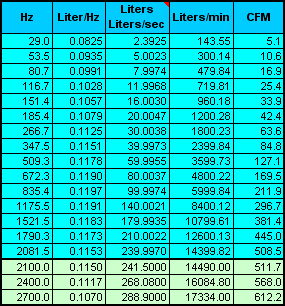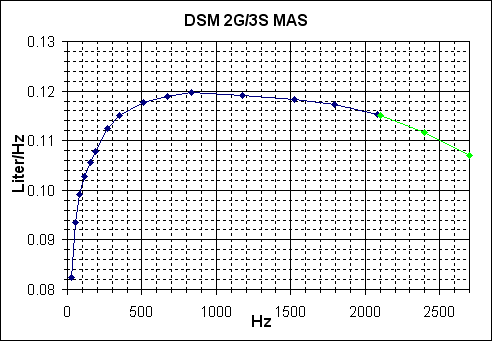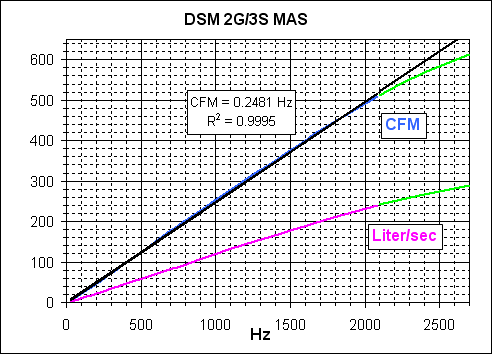3000GT MAS Karman Hz to Air Flow Conversion
by Jeff Lucius
The Karman frequency to air flow conversion information on this web page is based on information posted by Jeff Oberholtzer to the DSM-ECU Yahoo! Group in January, February, and August 2005. The data are derived from Mitsubishi and are for the second generation DSM Eclipse (2-L, turbo model; 1995-1998) Karman mass air-flow sensor (MAS). This MAS has Mitsubishi part number MD183609, which is the same part number installed on 1994-1998 3000GT Z11A models (FWD, 3-L, DOHC, non-turbo). CAPS reports the 3000GT VR4 (Z15A and Z16A models) had MAS part number MD170165 installed in 1991-1993 models and MD183618 installed in 1994 to 1999 models. According to the Mitsubishi charts, the VR4 MASs should have identical flow calibration to the Z11A MD183609 MAS.
The data and charts are available in a password-protected Excel file at misc/3s_mas_liter-per-hz.xls. Only the cells that are yellow can be edited. These three yellow cells let you convert the volume air flow to mass air flow (lb/hr) and to approximately translate the volume air flow as seen by the engine control unit to the volume air flow a converted MAS is actually measuring (such as a Ford-type MAS used with the ARC2-GP and PRO-M, or the GM-type MAS used with the MAF-T) when larger-than-stock fuel injectors are used. Values in other cells cannot be altered without un-protecting the spreadsheet.
Jeff Oberholtzer provided the Hz and Liter/Hz data for Hz values from 29 to 2081.5. From these, I extrapolated the Liter/Hz values up to 2700 Hz. To calculate air flow I multiplied the Hz value times the Liter/Hz value. This product has units of liters. A time unit is required to convert this volume to volume flow. I assumed the time unit is seconds. A time unit of minutes makes the flow too small to be practical. It is possible the time unit is a fraction or multiple of a second, but the cubic feet per minute (cfm) flow resulting from assuming the time unit is seconds is a reasonable match from our collective experience with this MAS. Supposedly these MASs will send a signal up to about 2700 Hz before "dropouts" ("missed" vortex counts) start to occur. At 2700 Hz I estimate actual airflow would be about 612 cfm, which is less than the maximum combined air flow from the two factory (in Europe) TD04-13G turbochargers installed on the VR4 (~750 cfm) and a bit more than the maximum flow from the single TD05H-14B turbocharger (~500 cfm) installed on some DSM turbo models. Some owners have reported Hz counts in excess of 3500 on their VR4 models. We still have more learn about this MAS.
Jeff O. also notes that the MAS's signal changes with temperature. When the signal is 2081.5 Hz, at -30ºC flow is ~0.1091 liter/Hz, at 25ºC flow is ~0.1185 liter/Hz, which is what is shown in the table below, and at 80ºC flow is ~0.1185 liter/Hz. Jeff didn't say what the temperature dependence is at lower signal values, nor if there is a dependence on barometric pressure. Compared to values shown in the table below at 25ºC (77ºF), 80ºC flow (L/Hz) is ~2.77 percent higher, and -30ºC flow is ~5.38 percent lower. These values do not correspond to the relative differences in air density at these three temperatures, assuming the same pressures: -30º air is ~13.76 percent denser than 25ºC air, 80ºC air is ~15.57 percent less dense than 25ºC air. In the engine control unit (ECU) there is a MAS compensation table that accounts for the different liters/Hz rates shown below. The ECU also applies a temperature correction for the flow.

The chart below graphically illustrates the non-linearity between the frequency count (Hz) and the unit MAS volume flow measurement at each frequency.

To convert liter/sec flow to cfm, multiply liter/sec times 60 to get liter/minute and multiply that value times 0.035315 to convert to cubic feet per minute. The green lines in the charts above and below are my extrapolations of Oberholtzer's values. I had Excel fit a linear trendline through Oberholtzer's values and forced the y-axis intercept to be zero. Even though the fit is very good, the measured flow departs slightly from a strictly linear relationship with Karman count. The departure is more obvious at the upper limits of the MAS's reporting range (above 2100 Hz). Even though it is not shown here, there is a temperature correction that also must be applied to the reported frequency count. These values are noted on the spreadsheet.

NOTE: The information presented here and in the spreadsheet should be used only to estimate volume air flow based on Karman count.
Page last updated April 23, 2006.



